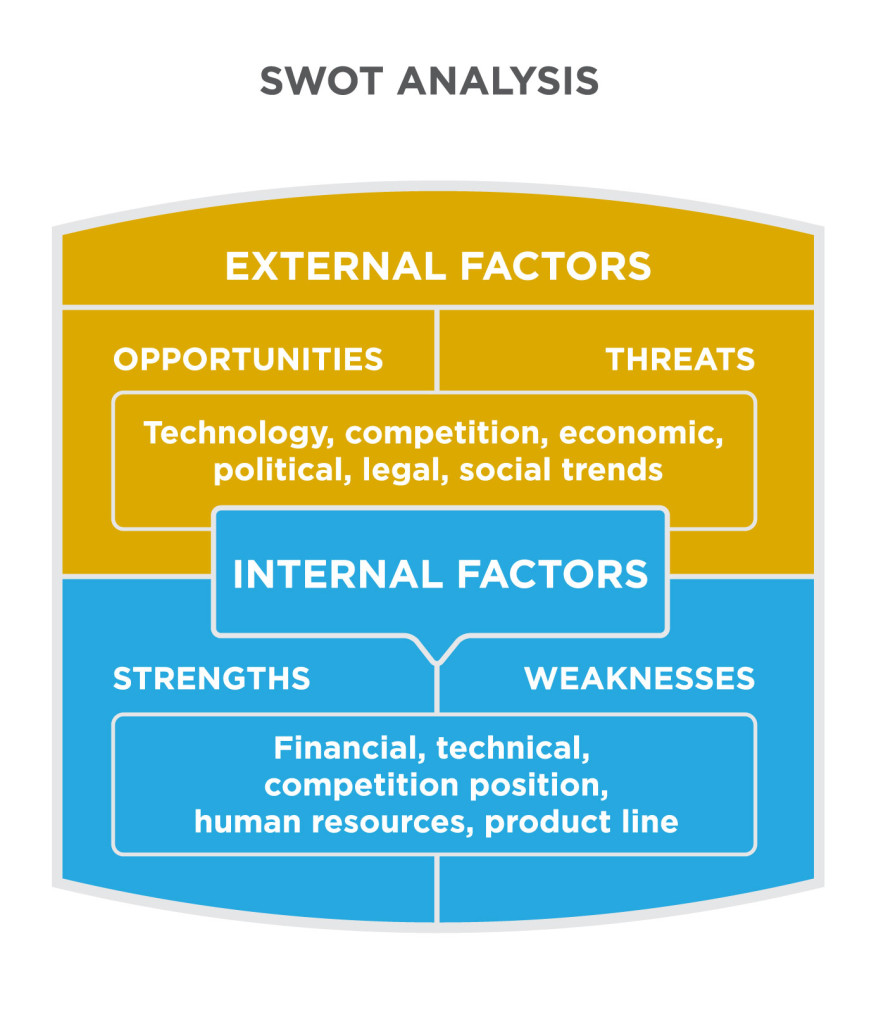Reading: SWOT Analysis
A situation analysis is often referred to by the acronym SWOT, which stands for strengths, weaknesses, opportunities, and threats.
Essentially, a SWOT analysis is an examination of the internal and external factors that impact the organization and its strategies. The internal factors are strengths and weaknesses; the external factors are opportunities and threats. A SWOT analysis gives an organization a clear picture of the “situation” in which it operates and helps it identify which strategies to pursue.
Internal Factors
Strengths and weaknesses include the resources and capabilities within the organization now. Since the company has the most control over internal factors, it can craft strategies and objectives to exploit strengths and address weaknesses. Examples of internal factors include the following:
- Financial resources
- Technical resources and capabilities
- Human resources
- Product lines
All of these are controlled by the organization. Competitive positioning can also be a strength or a weakness. While competitors’ strategies and tactics are external to the company, the company’s position relative to the competitors is something that it can control.
External Factors
External factors include opportunities and threats that are outside of the organization. These are factors that the company may be able to influence—or at least anticipate—but not fully control. Examples of external factors include the following:
- Technology innovations and changes
- Competition
- Economic trends
- Government policies and legislation
- Legal judgments
- Social trends
While a company can control how it positions itself relative to the competition, it can’t control competitors’ actions or strategies.
Benefits of a SWOT Analysis
A SWOT analysis benefits organizations in two key ways:
The SWOT Analysis Encourages Realistic Planning
Imagine a growing company that is able to attract new customers more easily than the competition because it has a strong reputation and visible leader. These strengths should be considered and exploited in the strategy. Now imagine that the company also has a poor history of delivering on customer commitments. If this weakness is not addressed, it will not only make it difficult to retain customers but also likely damage the reputation of the company and its leader—which would eliminate key strengths. By conducting a situation analysis, the company is more likely to consider both of these factors in its planning.
The SWOT Analysis Improves Ability to Forecast Future Events
What’s the worst thing that could happen to your business? Most organizations can answer this question because they have assessed the environment in which they operate. For instance, perhaps they know of pending legislation that might adversely affect them. Or perhaps they recognize legal risks or unique challenges from past economic cycles. By considering threats and “worst-case scenarios” during the planning process, organizations can take steps to avoid them, or minimize the impact if they do they occur.
SWOT Analysis Example
A situation analysis can benefit any organization. The example below shows the SWOT analysis for a fictional college.
Even this rudimentary analysis highlights some strategic issues, discussed below, which the college needs to consider.
Internal
The college has a number of strengths. Committed faculty and trusted leaders have collaborated to build academic programs that are showing high completion rates among students. The student advising program is also contributing to that success. Also, the college has excellent relationships with businesses in the community.
Among the weaknesses, the technology infrastructure is outdated. The college also employs a large number of part-time faculty members but doesn’t provide them with adequate training or support. Nursing, one of the more expensive programs at the college, is not attracting enough students to keep it full. Also, the college has learned from some of its recent graduates that students are not receiving transfer credit at the local university for all of their courses taken at the college. The students wonder if the college faculty and advisers really understand their academic goals or the requirements of the four-year degree programs at the university.
By completing a SWOT analysis, the college can shape its strategies and objectives to align with both the internal resources and capabilities it has, as well as the external factors it faces.
External
 The college leadership is feeling pulled by conflicting economic factors. The region has been through an economic downturn, which resulted in cuts to state funding. At the same time, an economic recovery has just begun. During the previous economic recovery, college enrollment dropped when students who were pursuing additional education returned to the workforce. How might the timing of those two funding issues work out? The college is also being affected by a local institution that is aggressively marketing to its students— especially students in the nursing program.
The college leadership is feeling pulled by conflicting economic factors. The region has been through an economic downturn, which resulted in cuts to state funding. At the same time, an economic recovery has just begun. During the previous economic recovery, college enrollment dropped when students who were pursuing additional education returned to the workforce. How might the timing of those two funding issues work out? The college is also being affected by a local institution that is aggressively marketing to its students— especially students in the nursing program.
Still, there are opportunities. Students have expressed interest in more online courses and programs. That might also slow the local competitor, though it would also require the college to address its aging technology infrastructure. The college has identified a number of innovative programs that would enable students to earn degrees more quickly and at the same time expand its partnership and collaboration with local businesses.



